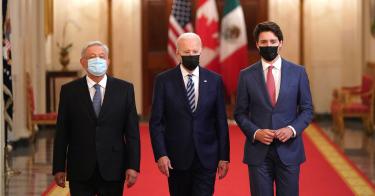During last November’s North American Leaders Summit, leaders agreed on several aspirational goals. There remain several looming challenges, however, that U.S. President Joe Biden, Canadian Prime Minister Justin Trudeau and Mexican President Andrés Manuel López Obrador could not resolve.
November’s so-called Three Amigos summit marked a turning point in a trilateral relationship previously strained by finger-pointing rhetoric that had led to threats of withdrawing from the North Atlantic Free Trade Agreement, or NAFTA. The summiteers reaffirmed the importance of regional cooperation to offset China’s rising influence. They also pledged to further integrate their economies, strengthen supply chains, tackle illegal immigration, and prepare for the next pandemic.
But the positive summit messaging should not obscure the fact that U.S.-Mexico relations still face profound obstacles. If the trilateral partnership is to succeed, the Biden administration must invest in new and creative ways to repair the U.S.-Mexico leg of the trilateral stool.
Not all is doom and gloom in the bilateral relationship. There are good reasons to be optimistic about U.S.-Mexico relations. Our two countries are more interconnected than ever. More Americans live in Mexico than in any other foreign country, while roughly one quarter of immigrants living in the United States were born in Mexico. The San Ysidro checkpoint, reopened to nonessential travel on Nov. 8, is the busiest land border crossing in the Western Hemisphere.
>>> Biden Missed Mark, Opportunities at “Three Amigos” Summit With Canada, Mexico
We are also each other’s top trading partners. Mexico accounted for roughly 15% of total U.S. trade in 2021 through November. Trade volumes are expected to increase as the U.S.-Mexico-Canada Agreement (USMCA) negotiated during the Trump administration is fully implemented. USMCA has already helped North America recover more quickly from the COVID-19 pandemic. With the updated trade agreement, we have a framework for strengthening the continent’s supply chains.
No country is likely to back out of the new trade agreement, which is widely seen as more favorable to the U.S. than NAFTA was. AMLO, meanwhile, relies on regional trade and financial flows to underwrite his signature infrastructure and social programs known as the Fourth Transformation.
The two nations are talking frequently, too. U.S, Vice President Kamala Harris visited Mexico City in June. The U.S.-Mexico High-Level Economic Dialogue and the High-Level Security Dialogue were held in September and October, respectively. Despite the continuing bilateral engagement, though, many problems remain unresolved, and some rifts are widening.
At the November Summit, tensions ran high over a consumer tax credit for U.S.-made electric vehicles tucked into the Build Back Better Act. Mexico and Canada argued the tax credit would harm their auto industries by incentivizing manufacturers to relocate to the U.S. This, they said, would violate USMCA and the World Trade Organization’s rules against import substitution subsidies. Hopefully, tensions have eased now that Build Back Better has failed in the U.S. Senate.
Meanwhile, Washington is watching with growing alarm as AMLO attempts to limit private investment, this time in the Mexican energy sector. In what amounts to asset seizures, the AMLO administration has forced the closure of at least 23 fuel facilities and partially closed another 17, often without reasonable cause. A weak legal system in Mexico offers little recourse. The Mexican government is also edging out U.S. companies by arbitrarily suspending and denying permits and passing laws that favor the state-owned energy entities Petróleos Mexicanos (PEMEX) and the Federal Electricity Commission (CFE).
In September, AMLO escalated tensions with the United States by proposing three constitutional amendments to nationalize the electricity sector, forcing private companies to sell to CFE at prices set by the commission itself. This would guarantee CFE a 54% market share and crowd out renewable energy producers. Should Mexico’s Congress approve the amendments in April, Mexico will be in blatant violation of the USMCA and other international trade agreements.
>>> It’s Time to Amplify and Elevate Certainty on Trade Freedom
Washington and Mexico City are also at odds over how to curb record levels of illegal migration along the U.S.-Mexico border. Both countries agree on the need for a regional approach to migration and some progress is being made with post-summit commitments to crack down on transnational crime and to contribute additional development funds for Latin America. But the Biden administration has yet to develop a cohesive border strategy. This impairs its ability to work with or respond to its southern neighbor on migration issues.
AMLO has called on the United States to ease immigration restrictions, largely because remittances from Mexican migrants play a critical role in supporting Mexico’s economy. Remittances surpassed $40 billion in 2020 and are on track to surpass $50 billion this year. Meanwhile, Biden’s advisors are reportedly split over the broad direction of U.S. immigration policy, with some wanting to focus on deterring migrants and others seeking to speed up asylum application proceedings. In August, a federal court ordered the administration to reinstate Trump’s “Remain in Mexico” program, forcing asylum seekers to stay in Mexico until their asylum court dates are set.
The North American Leaders Summit was a welcome step in promoting greater regional cooperation. But the work does not end there, and the unresolved squabbling undermines the alliance. It’s time for President Biden to develop a cohesive strategy that tackles both new and lingering U.S.-Mexico tensions head on.
This piece originally appeared in RealClear World



